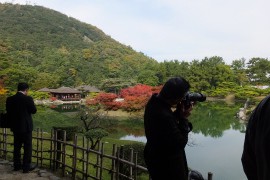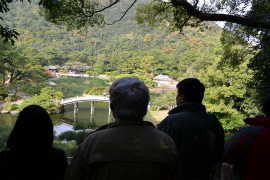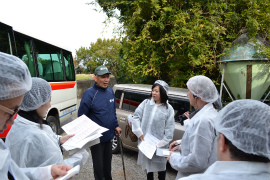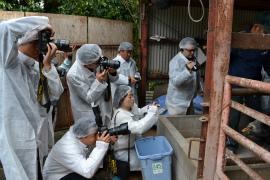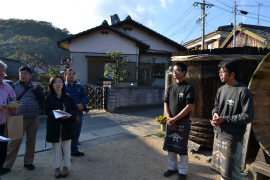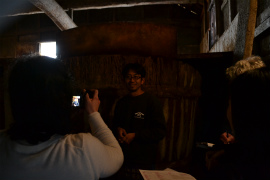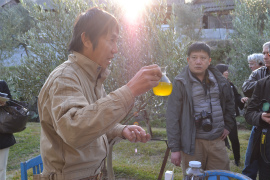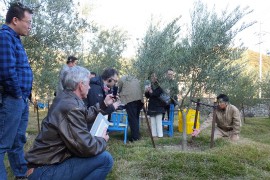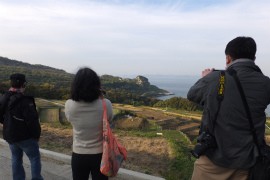Date : November 20 - 21, 2014
Report: Kagawa Press Tour “Island Challenges”
post date : 2014.12.08
This press tour was jointly planned and sponsored by the FPCJ and Kagawa Prefecture, and had 10 journalists participate from China, Hong Kong, Taiwan, South Korea, Germany, Italy and the USA. Despite the population in rural areas declining, there are islands in the Seto Inland Sea with increasing numbers of new young residents and visitors. This press tour visited Shodoshima, where employment opportunities for youth are being created through production of local specialties with high added value, and Teshima, where the beauty of the island is demonstrated through art while the issue of illegally dumped industrial waste is also dealt with. (Click here for tour details)
[Day 1: Takamatsu and Shodoshima]
1. One of Japan’s Finest Gardens, Ritsurin Garden
After arriving at Takamatsu Airport, first the journalists visited Ritsurin Garden in Takamatsu City. The garden is 400 years old, and is designated as a Special Place of Scenic Beauty by the Japanese government. Mr. Ichiro Kawata, the head gardener, guided the tour around the massive garden, which was made to display the beauty of the four seasons and have scenery that changes as one walks around it. There is even a miniature hill that was made to resemble Mt. Fuji, for the local lord who was not able to travel. The journalists heard about gardening methods and the history of the garden from Mr. Kawata as they filmed and photographed the Japanese garden in its fall splendor.
(Photo, right: Journalists view the garden from the hill resembling Mt. Fuji)
2. Shodoshima Brand Olive Cattle Farming
The tour travelled by ferry from Takamatsu Port to Shodoshima, and visited the cattle shed of dairy farmer Mr. Masaki Ishii to learn about Shodoshima’s brand of olive cattle. Mr. Ishii explained that “When I heard that olives were good for you, I thought they might be good for cattle too.” In addition to explaining why he started feeding leftover olives to cattle, he also described how the olive cattle became well-known throughout Japan and why the meat is delicious. The journalists seemed to be convinced with Mr. Ishii’s explanation after they ate olive cattle for lunch. While filming the cattle as they were given olive feed, journalists asked about differences with other Japanese cattle, the impact of Abenomics, foreign workers and whether there was someone to succeed the business.
3. Yamaroku Shoyu, Protecting Traditional Flavor
“Only 1% of Japanese soy sauce makers are using wooden barrels nowadays,” according to Mr. Yasuo Yamamoto, the 5th-generation president of Yamaroku Shoyu. He is working to protect traditional production methods and directly inform consumers about the quality and value of those methods. Some youths who had previously left the island but later returned, as well as youths moving from other areas, did so out of a desire to work at Yamaroku Shoyu. The journalists entered a storehouse built over 100 years ago, and heard about why Mr. Yamamoto insists on using wooden barrels and what made him decide to take over the family business (Photo, left). Journalists asked about the time and cost necessary to make a wooden barrel, sales trends, whether many people visit the storehouse despite the declining population, the benefits of living in a rural area, and other questions. The journalists also interviewed workers at Yamaroku Shoyu that had returned to or newly moved to the island (Photo, right), asking questions such as how many of the young people who moved to the island would become permanent residents.
4. Yamada Olive Farm, Cultivating the First Organic Olives in Japan
The journalists visited Mr. Noriaki Yamada, who is growing organic olives. Mr. Yamada prepared a table surrounded by olive trees in the middle of the farm, and greeted the journalists with olive oil and salt-cured olives. He also showed an example of an olive weevil, a pest that is an issue for organic olive cultivation, and explained what countermeasures he was taking to prevent them. The journalists asked a variety of questions about Mr. Yamada’s lifestyle and managing the farm. In response to the question of whether he would suggest young people move to the island, Mr. Yamada replied “There are a lot of people with both the money and ability to take on unique challenges like growing organic olives.”
(Photo right: Mr. Yamada explaining his countermeasures to prevent olive weevils)
5. Inoue Seikoen, Creating Jobs Supporting New Residents
The journalists visited the head office of Inoue Seikoen, which sells food and skincare products made with Japanese olives. The head of advertising, Mr. Sadaki Yaso, gave an explanation of the company (Photo, left). Mr. Yaso described the company’s handmade oil that uses the precious olives grown on Shodoshima as “more a work of art than a commercial product”. Company president Mr. Tomohiro Inoue explained that his business philosophy was to “help make areas supporting agriculture more affluent”. Inoue Seikoen is at the forefront of providing youth employment opportunities, with many of their employees returning to the island or moving there from other areas. Journalists asked questions about why the company had become so large, its number of employees, the economy and the effects of Abenomics. The journalists then interviewed four employees who had returned to the island or moved from elsewhere (Photo, right), asking about life on Shodoshima and why they returned to or moved to the island.
6. Initiatives by the Town of Shodoshima to Encourage New Residents (Shodoshima Mayor)
To finish off the first day, the journalists visited Shodoshima Town Hall, and spoke with Mayor Yukio Shiota about initiatives implemented by the town. “The population of Shodoshima has halved during my lifetime. The population decline of this island is a preview of what the future holds for Japan.” Despite this situation, the mayor emphasized that “It is important for local governments not to rely on the national government like they did in the past, but instead to develop their own initiatives for stimulation.” The journalists asked questions on whether the mayor thought new residents had sufficient employment and support from the town, what the budget was for encouraging new residents to live there, whether he thought rural areas were relying too much on the central government, and what he would like to say to the Minister in charge of Overcoming Population Decline and Vitalizing Local Economy in Japan given the chance.
[Day 2: Teshima]
7. Teshima no Kokoro Museum, A History of the Island Residents’ Struggles
On the morning of the second day, the tour travelled by ferry from Shodoshima to Teshima. The first stop there was the Teshima no Kokoro Museum on the western edge of the island, where the journalists heard from Shozo Aki, director of the Teshima Resident Council against Industrial Waste Dumping. Mr. Aki passionately explained the background behind industrial waste being illegally dumped on Teshima, the health issues it caused residents, how the resident movement came about, and events since the dispute arbitration agreement (Photo, left). The journalists asked questions such as whether all the residents were unified in their efforts, what his opinion on nuclear power plants in Japan was, and when the clean-up process would be completed. In his responses, Mr. Aki stated that “We cannot pass this debt on to future generations.”
(Photo, right: Mr. Aki photographed in front of a memorial)
8. Facing Mistakes of the Past: Waste Processing Site and Kagawa Naoshima Environment Center, Teshima Section
After visiting the Teshima no Kokoro Museum, the journalists went to see the Teshima industrial waste processing site located beside it. Assistant General Manager Masaya Komino of the Kagawa Prefecture Recycling and Waste Management Section explained that processing of the dumped waste is already 80% completed, and after that is finished they will continue processing the contaminated water (Photo, left). The journalists then put on rubber boots, masks and helmets to go observe the site where industrial waste remains, and film the piled waste that had been dug out of the ground. The journalists from Asia in particular mentioned that viewing the site was informative and their countries could learn from it.
9. Shima Kitchen, Youths and Local Women Promoting the Island’s Appeal
The journalists ate lunch at Shima Kitchen, a restaurant where youth who have returned to or newly moved to the island work alongside the women of the island, and interviewed the manager and other staff. The manager, Ms. Megumi Fujisaki, said “Together with the island women, I would like to show how appealing the island is.” The journalists asked about what difficulties she faced upon returning to the island, what is necessary to convince youth to return to rural areas, and what life was like on an island with only a limited number of young people.
10. Teshima Art Museum and Rice Terraces, Merging Modern Art with Island Scenery
Next, the journalists spoke with Ms. Ayako Amari, director of the Setouchi Koebi Network NPO, about the NPO’s activities (Photo, left). Ms. Amari said “Our goal is to bring smiles to the faces of the older island residents,” and explained the varied volunteer activities they were involved in such as the Setouchi International Art Festival, monthly birthday parties held on the island, and running Shima Kitchen. The journalists then visited the Teshima Art Museum, designed to blend into its natural surroundings, and viewed art based on the theme of water. Some journalists interviewed foreign tourists who had come to visit the museum. Ms. Amari was asked by the journalists about the response of local residents and about people who had returned to or newly moved to the island. The tour concluded by visiting and photographing the beautiful rice terraces in the area around the Teshima Art Museum (Photo, right).




